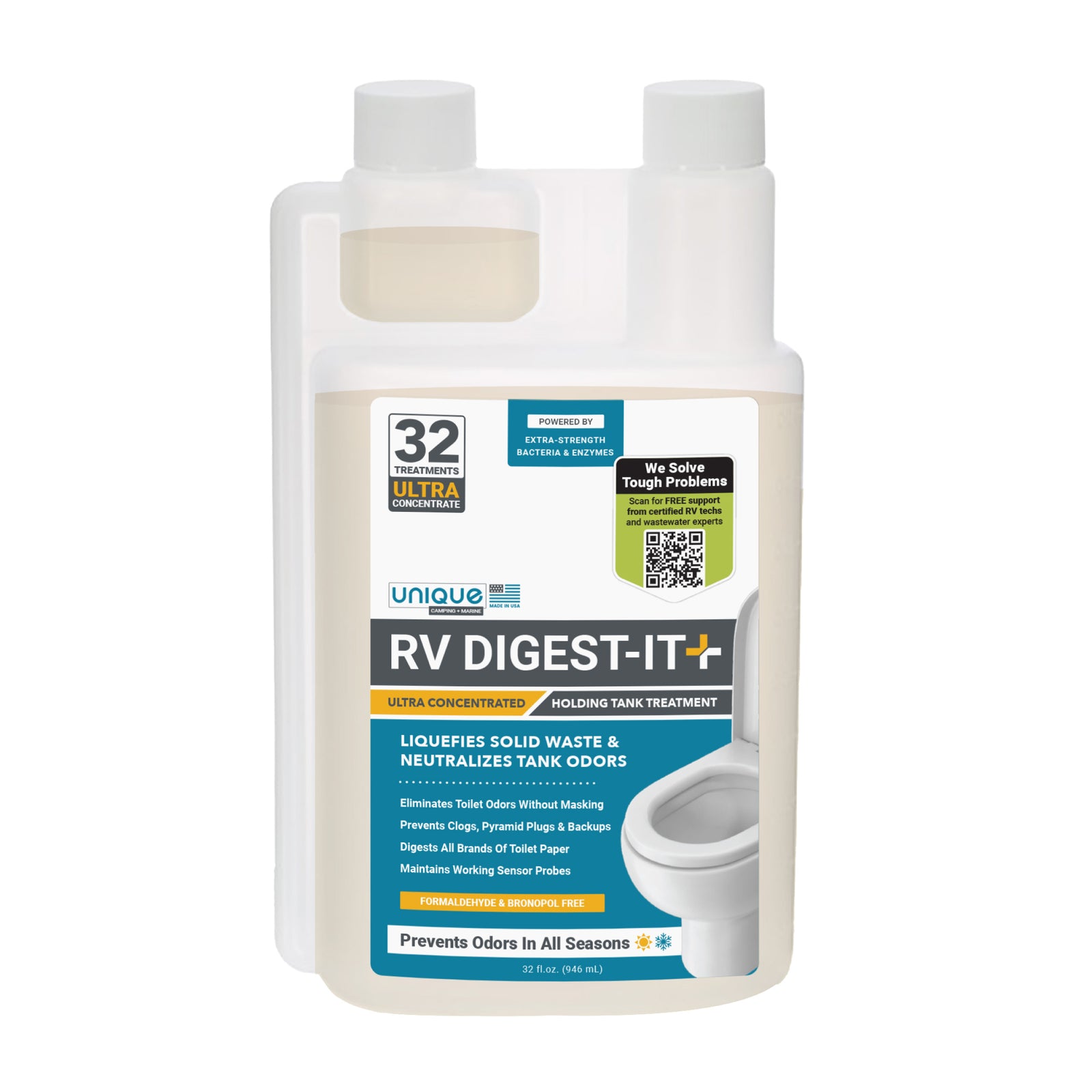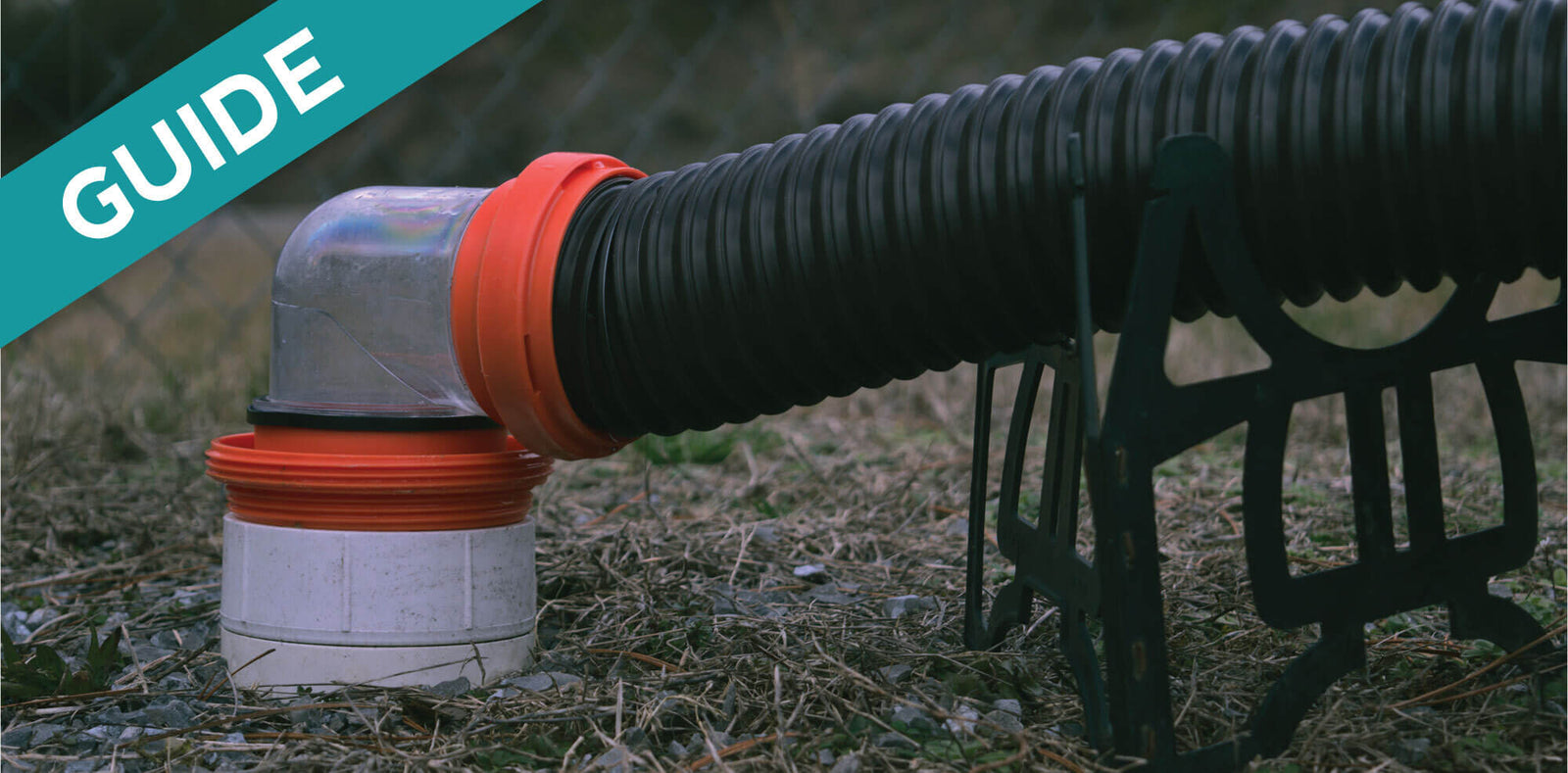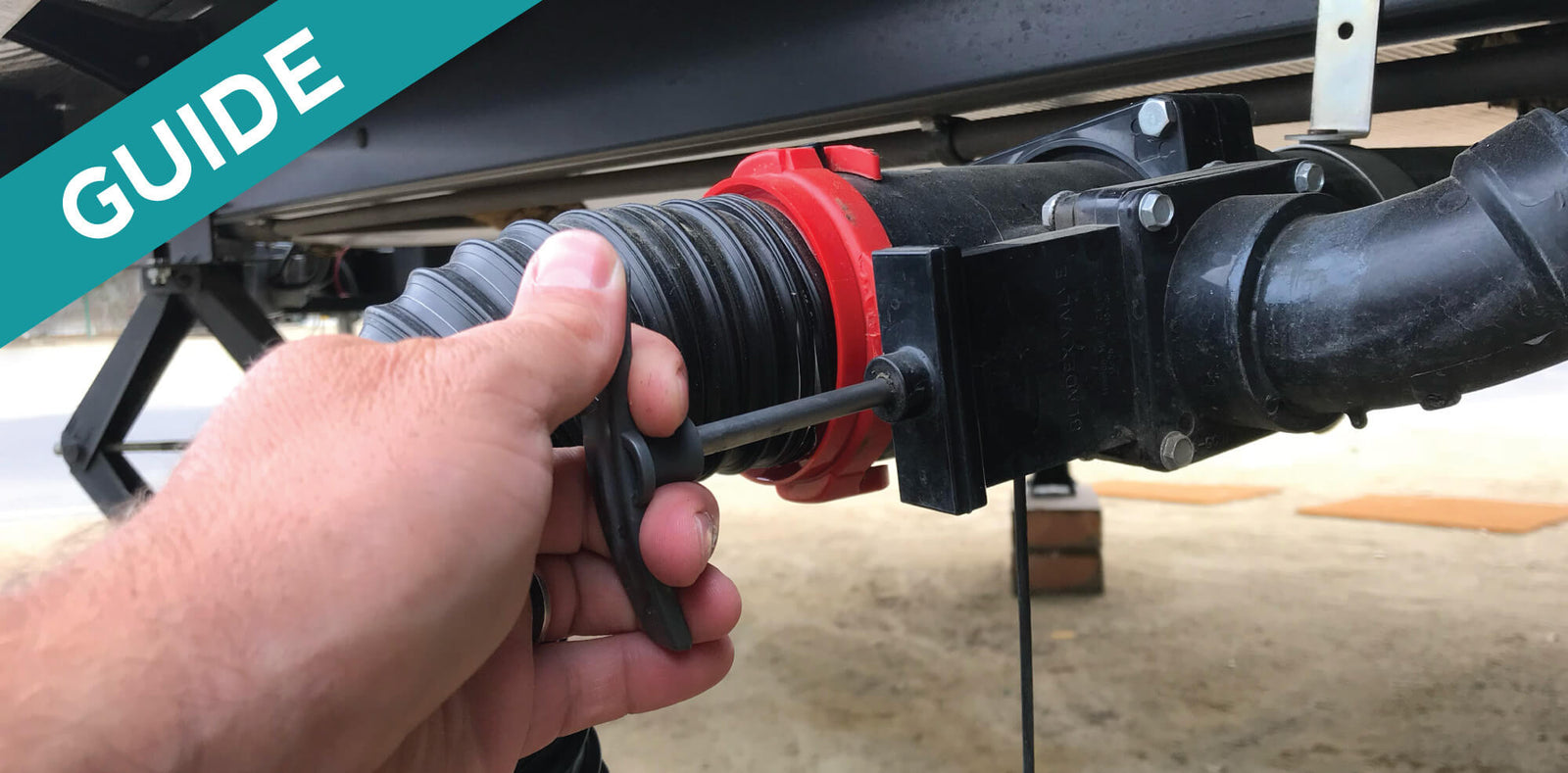
Key Points:
- Common sense dumping practices are easy to remember and worth practicing to show respect to other RVers waiting in line.
- Basic etiquette is to dump as quickly as possible, avoid flushing your tank if there’s a long line, and clean up after yourself (basically leave the station as tidy as you would want others to leave it for you).
When you’re new to RVing, you never really want to look like you’re a newbie, and going to a dump station for the first time is one place where your inexperience can certainly show through. But it’s not something to be afraid to do because it’s really very simple as long as you operate by two main guidelines: dump as efficiently as possible and clean up after yourself. It all basically boils down to that. But we want you to be a model dumper, so in this article, we’ve explained in detail some of the finer points of dump station etiquette so you can be sure not to annoy the wrong camper.
Tips and Advice for Dumping Respectfully
There are certain common sense things that you would think most people would make a part of their dumping routine to not only keep themselves and their RV sanitary and clean, but also the dump station and the people around them. Unfortunately, some people do not possess these dump station etiquette and can easily be the target of a dumping station’s version of road rage. If you’re new to RVing, there’s nothing to be afraid of when showing respect to other RVers at a dump station. We’ve compiled some common sense tips and advice to make your dump station experience incident-free.
- Ensure the RV is aligned properly with the dump station sewer port
- Dump the black tank first, then gray to partially rinse your sewer hose
- Keep wastewater valves in proper working order
- Don’t spread germs (have the appropriate tools to dump)
- Move your RV out of the way to access fresh water (drinking/potable water)
- Try to complete your dumping process as quickly as possible if there is a line.
- If there isn’t a line, thoroughly rinse the black tank after the initial dump.
- Don’t perform non-dumping tasks while hooked up to the dumping cleanout
- Clean up after yourself
We’ll go into greater detail on all of these tips so you can have the most comprehensive idea of how to operate at a dump station.
Ensure the RV is aligned properly with the dump station sewer port
Getting your RV properly lined up with the sewer port will allow for an easier, quicker dump of both the black and gray water holding tank. As with filling your car up with gas, make sure you know which side of the RV the discharge port and valves are on so you can know which side of the dump station to pull in on. Dump stations typically have a direction to pull through and some have multiple lanes which can allow you to choose which side of the RV to dump from. They may not always be on the same side as your RVs discharge port.
If you find your RV discharge port and dump station sewer port are on opposite sides, you may need to have a long enough sewer hose, or multiple connected together, in order to reach the sewer port when you pull the hose under the RV.
From there, if you have a passenger with you, it is a good idea to have them stand alongside the RV so that you can see them in the mirrors in order to know when you are the shortest distance to the sewer port from your RV's sewer discharge port.
If you do not have a passenger with you, it is helpful to have a good idea where the discharge port is on your RV and then use markers that you find around the dump station to help you orient the RV close to the sewer port. Some examples of markers can be: larger rocks, painted curbs or even cracks or pour lines in the concrete. It really depends on the dump station as to what is available to help you orient the RV as close to the sewer port as possible.
If you get it wrong the first time, it’s totally okay to try again. It will be faster to be aligned correctly than to be battling your waste hose like a rookie snake charmer only to find you can’t reach the dump stations sewer port.
Dump the black tank first, then gray
After having read through this dumping series, you know that the black tank should always be dumped first, but let us reiterate it again. Dump your black tank first so that if you are not able to flush your black tank at the dump station or there are too many in line behind you to do that, your gray water dump will decently rinse the hose before storing and heading home. It seems much less gross to disconnect the discharge hose after the gray water rinsed it out than if the black water had just gone through. No one wants to disconnect and see chunks hanging out in the grooves of the hose and potentially watch them fall out onto the ground. Observe the best dumping order to respect others waiting in line and the cleanliness of the area. If there is no line however, we still highly recommend rinsing the black tank whenever possible.
Keep wastewater valves in proper working order
These are the gate valves you pull when you’re hooked up to a cleanout and are ready to dump. However, the more you use these valves, the more they wear out like anything that is used often. RV gate valves keep your holding tank waste safely sealed until you can connect a hose and dump. But the more you use your RV, the more those gate valve seals will wear out and allow waste water to drip through the valve even when closed, causing a minor mess after uncapping the discharge pipe to hook up. You do not want to be the one to leave a puddle of contaminated water at the feet of the next RVer in line. You can find twist-on wastewater valves that are designed the same way as the manufacturer-installed valves, but they twist on to the end of the discharge pipe. You can add one of these as a secondary defense against dripping from a worn valve.
It is a good idea to inspect the valve(s) and seal(s) after dumping the black and gray tanks periodically. After you have dumped (and rinsed) the black and gray tanks, place a bucket under the discharge port in order to catch any potential drips. Then slowly open the valve(s) and inspect them to see if there is any debris that may be caught or may be going to be caught in the path of the knife valve or the gaskets. If you do find something, it is a good idea to use the water supply and a black water specific hose to rinse off the valve and the gaskets, allowing any of the debris and rinse water to be collected in the bucket, which you can then pour into the dump station sewer port.
Don’t spread germs
Have all the appropriate tools to dump your tanks in a sanitary way. Don’t try to DIY a sewer hose or some other essential tool. Invest in manufactured items that ensure tight seals and non-drip dumping. We also recommend always wearing disposable rubber gloves to protect yourself from any germs that escape during the dumping process and having sanitary wipes on hand to wipe down contaminated surfaces to protect future RVers from being infected by any residual germs.
In order to reduce anxiety at the dump station, ensuring that you have a long enough hose or hoses to reach under the RV and make it to the sewer port is a good idea. We also recommend making sure you have a dedicated fresh water hose that you use only for dumping/ rinsing purposes. This will ensure that you don’t have too short a hose, and can help prevent spills and messes, and
Move your RV forward to access fresh water (drinking/potable water)
There will be a freshwater hookup at the sewer port, but we can’t stress this enough, do not use this to fill your freshwater tank. It might seem convenient, but in reality, it takes up valuable time not to mention the water spigot is potentially filthy and contaminated. Fresh water hook-ups at the sewer port should only be used for rinsing your holding tanks.
By moving your RV out of the way to an allocated fresh drinking water spigot (if there is one available), you are allowing another RVer to begin the dumping process and keep the line moving. Many RVers have had an experience being stuck behind someone who takes up to an hour to dump, when it should really only take 15 minutes at most. Don’t be that guy.
Try to complete your dumping process as quickly as possible
Ever been sitting in a drive-thru line behind someone who has been ordering for what seems like 15 minutes when it should only take a couple minutes? The first reaction is often, “What, are you ordering the whole store?!” If you take too long to dump, you may have people behind you wondering if you’re dumping an entire septic tank. And most of the time, the act of dumping the tanks is not the time-consuming part; it’s all the other little things people decide they must do before moving out of the way for the next person. Other blogs may say you should never flush your black tank at a dump station out of respect for other RVers in line. There’s nothing wrong with rinsing your tank after dumping, but try to do it as quickly and efficiently as possible, or if there is a very long line, it’s okay to skip a rinse from time to time. You can always rinse your tanks once you’re on full hook-ups, or if you’re feeling risky, throw caution to the wind and just deal with the ire of your fellow RVers and rinse anyway.
Don’t perform non-dumping tasks while hooked up to the dumping cleanout
Some RVers think this is the perfect time to do dishes, take showers, casually chat on the phone, or even snack on something! Dish washing and showering should be done before you get to the dump station or when you get home. There’s really no reason to wash dishes or shower while hooked up at the dump station. Wait to perform any activities that are not dumping related until you’ve arrived home or have moved away from the cleanout. While you may be able to talk on the phone and dump at the same time (ew, sanitize your phone after you sicko), RVers behind you in line won’t see it that way. Talking on your phone or doing other non-dumping tasks while dumping makes people think you are in no hurry and their time is not being respected. Avoid the perception that you are the disrespectful RVer; put away the hackysack, focus on dumping, and get on the phone after you’ve moved out of line.
Clean up after yourself
You’d think it goes without saying, but don’t litter. Put your disposable gloves and other waste products from cleaning up after your dumping process in the proper waste bins to keep the dump station clean and sanitary for the next person. Some stations may not have convenient trash cans or the trash cans could be completely full. Just put your used gloves or used wipes in a plastic bag and take them home with you to your big dumpster. Don’t balance them on top of the overflowing trash or toss them at the foot of the trash can. The general rule of thumb is: leave the area cleaner than you found it.
How to Hook Up and Dump at a Dump Station
Luckily, we have an entire guide on that topic; refer to our guide on How to Dump Your Black and Gray Water Tanks. It’s pretty simple and you should have no trouble at all figuring it out. If you’re confused about anything, the RVer behind you has likely done it before and would probably be willing to give you some guidance; just ask!
Review
We’ve finally come to the end of our series on all things dumping! Let’s briefly review what we covered in this article:
- There is an assumed code of conduct for dump stations:
- Ensure the RV is aligned properly with the dump station sewer port
- Dump the black tank first, then gray to partially rinse your sewer hose
- Keep wastewater valves in proper working order
- Don’t spread germs (have the appropriate tools with you)
- Move your RV out of the way to access fresh water (drinking/potable water)
- Try to complete your dumping process as quickly as possible
- Don’t perform non-dumping tasks while hooked up to the dumping cleanout
- Clean up after yourself
If you’re unsure how to hook-up at a dumping station, refer to our guide on How to Dump Your Black and Gray Water Tanks.

Prevent Common Problems In Your Tanks!
From misreading sensors, preventing clogs, or eliminating odors, we've got you covered no matter how you camp! All our best holding tank tips and trick information plus more can be found conveniently in one place when you download our FREE Unique Method Field Guide PDF. Achieve holding tank bliss today!
Get The Free Download



